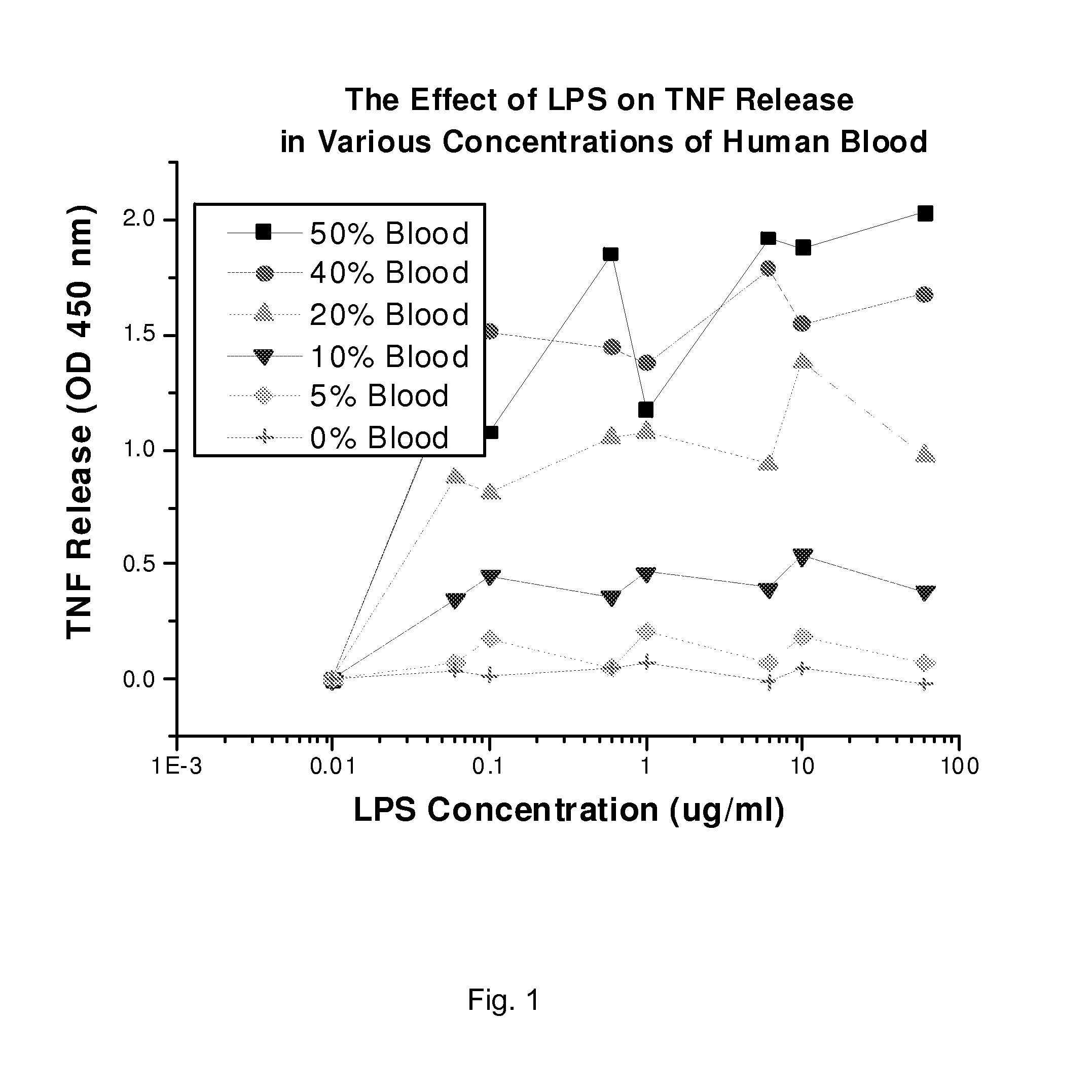Methods of treating inflammatory conditions with adrenergic antagonists
a technology of adrenergic antagonists and inflammatory conditions, which is applied in the field of methods of treating inflammatory conditions with adrenergic antagonists, can solve the problems of lethal to cells, tissues, organs, and hosts, and excessive blood or tissue levels of tnf , achieve the effects of reducing blood pressure of mammals, preventing detectable tnf production and/or release, and inhibiting il-1 production and/or releas
- Summary
- Abstract
- Description
- Claims
- Application Information
AI Technical Summary
Benefits of technology
Problems solved by technology
Method used
Image
Examples
example 1
Whole Blood Assay to Determine Quantitative Levels of TNF in Whole Blood.
[0052]We collected whole human blood in a polypropylene tube. Containing a final concentration of 10 units of heparin per ml of blood using gravity flow with 19-gauge needle. To prevent non-specific activation of cells, we used the blood within 30 minutes of draw. The blood was diluted with plasmalyte to 50%, 40%, 30%, 20%, and 10% concentrations. In a matrix based assay set up, each blood dilution was treated with various concentrations of LPS dosages ranging from 60 μg / ml, 10 μg / ml, 6 μg / ml, 1 μg / ml, 0.6 μg / ml, 0.1 μg / ml, and 0.06 μg / ml. The LPS treated blood was incubated at 37 degree in an incubator with continues rotation. Following the incubation, the blood was centrifuged and the plasma was evaluated for TNF quantification using the ELISA assay (BD Biosciences, Los Angeles, Calif.).
[0053]The results in FIG. 1, demonstrate a linear relationship between the concentrations of blood versus the release of mea...
example 2
Optimization of TNF Whole Blood Assay
[0054]We initially tested the ability of LPS to produce TNF from monocytes, by adding various dilutions of LPS (60 μg, 10 μg, 6 μg, 1 μg, 0.6 μg, 0.1 μg, 0.06 μg) per ml of diluted blood (blood dilutions 50%, 40%, 20%, 10%, and 5%). Blood dilutions were made in the clinically relevant buffer “plasmalyte”. LPS treated blood was incubated at 37° C. for 2 hr. Following incubation, we separated the plasma samples by centrifugation. We evaluated the samples using TNF-ELISA. As shown in FIG. 1, the LPS dose at 10 μg / ml is ideal for production of TNF. Relying on FIG. 1, we conducted a blood dilution curve with 10 μg / ml LPS (FIG. 2). Based on interpretation of FIGS. 1 and 2, we concluded that blood dilution of 20-25% would be ideal at an LPS dose of 10 μg / ml. Based on the FIG. 2 data, we found LPS causes a near linear increase of TNF production in 20% blood. Based on these data, we decided to use 20-25% diluted blood and 10 μg / ml blood to saturate the ac...
example 3
The Effect of α-Adrenergic Antagonists (Prazosin, Yohimbine, and Phentolamine) on TNF Inhibition
[0055]Using a whole blood assay, we tested the effects of the α-adrenergic antagonists (prazosin, yohimbine, and phentolamine) for the inhibition of TNF production in whole blood. Prazosin, an alpha 1A adrenergic antagonist, inhibited TNF at a low IC50 and demonstrated the lowest IC50 when compared with yohimbine (alpha 2A receptor antagonist) and phentolamine (alpha 1 and alpha 2 receptor antagonist). Prazosin inhibits TNF activity at 20 μg / ml drug concentration. Prazosin causes a definite inhibition of TNF α. Using prazosin treated samples, we observe nearly 100% inhibition at the upper range of the dose curve. These data suggest this compound can be used alone for the treatment of inflammation. It could also provide a possible treatment for rheumatoid arthritis. Yohimbine inhibited TNF with an IC50 in the 70-100μg / ml range (FIG. 3), with comparable potency to prazosin. Yohimbine (an al...
PUM
| Property | Measurement | Unit |
|---|---|---|
| Current | aaaaa | aaaaa |
| Weight | aaaaa | aaaaa |
| Pressure | aaaaa | aaaaa |
Abstract
Description
Claims
Application Information
 Login to View More
Login to View More - R&D
- Intellectual Property
- Life Sciences
- Materials
- Tech Scout
- Unparalleled Data Quality
- Higher Quality Content
- 60% Fewer Hallucinations
Browse by: Latest US Patents, China's latest patents, Technical Efficacy Thesaurus, Application Domain, Technology Topic, Popular Technical Reports.
© 2025 PatSnap. All rights reserved.Legal|Privacy policy|Modern Slavery Act Transparency Statement|Sitemap|About US| Contact US: help@patsnap.com



